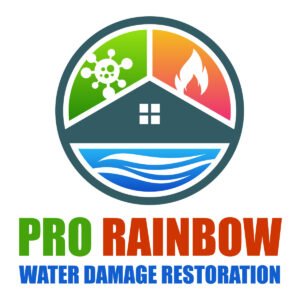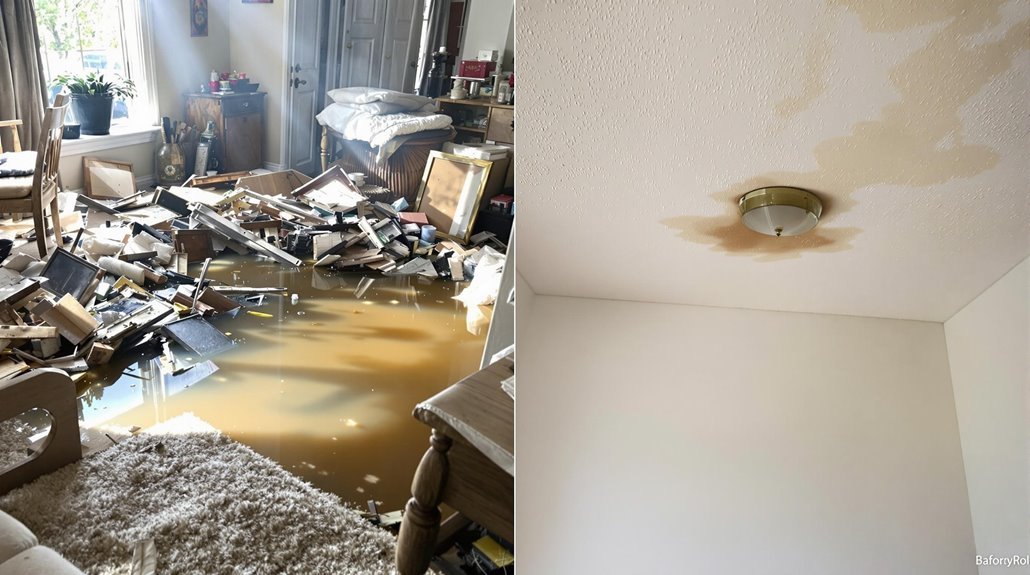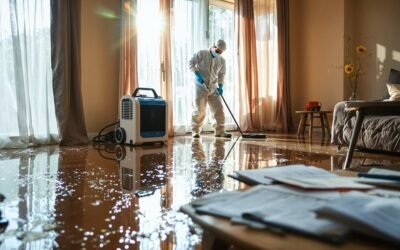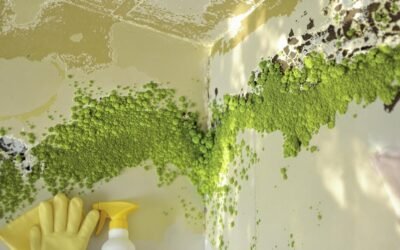Understanding the difference between flood and water damage matters for your property and finances. Flood damage typically occurs from natural events, requiring separate insurance policies that often exclude coverage for mold. Conversely, water damage results from issues like leaky pipes, usually included in standard homeowners' insurance. Misidentifying these issues can lead to significant financial loss and inadequate protection. Moreover, knowing the causes helps in implementing preventive measures. Grasping these distinctions ultimately safeguards your investment and guarantees you're prepared for restoration processes, which can drastically affect both value and safety. There's much more to uncover about this critical topic.
Key Takeaways
- Understanding the difference helps homeowners choose the right insurance coverage, as flood and water damage often require separate policies.
- Different causes of damage necessitate unique restoration processes, impacting repair timelines and costs.
- Recognizing damage types aids in early detection, preventing extensive property deterioration and mold growth.
- Knowing the distinctions influences property value assessments, especially in flood-prone areas, affecting resale potential.
- Effective preventive measures can be tailored based on the type of damage, enhancing property safety and resilience.
Definition of Flood Damage
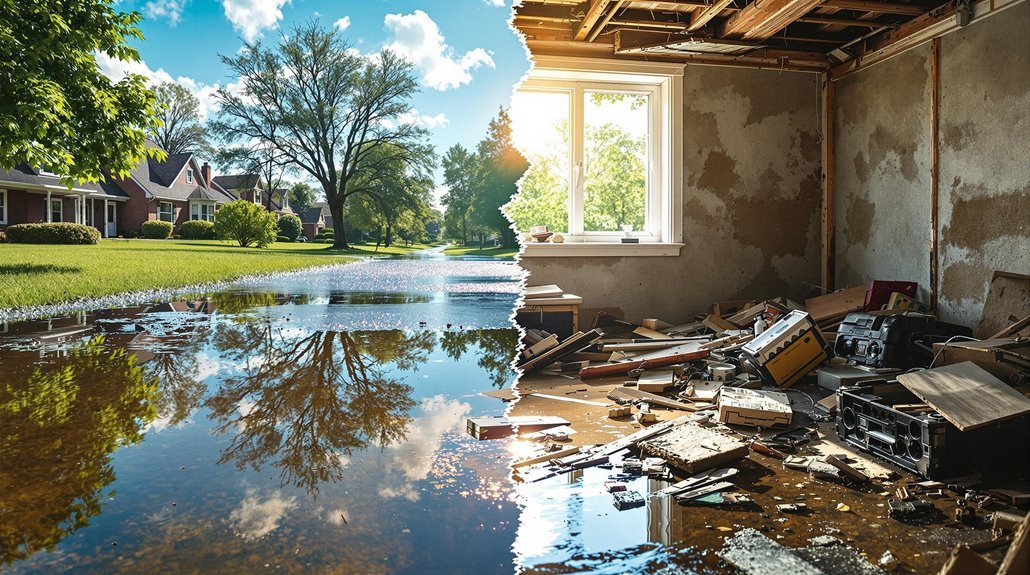
Flood damage refers to the destruction caused by the overflow of water onto normally dry land, often resulting from natural events like heavy rainfall, storm surges, or rapid snowmelt. You'll find that flood zones are designated areas where the risk of flooding is significant, often influencing property values and insurance requirements. Understanding these zones is essential for homeowners, as flood insurance can mitigate financial losses. While standard homeowners' policies typically don't cover flood damage, specific flood insurance policies are available to provide coverage in designated flood zones. By recognizing the importance of these distinctions, you can better prepare for potential risks and guarantee that your property is adequately protected against flood-related losses. Additionally, preventive measures can significantly reduce the risk of water damage in your home.
Definition of Water Damage
Water damage occurs when excess moisture infiltrates a structure, leading to deterioration and potential health hazards. Understanding water damage types is vital for effective water damage restoration. These types can be categorized based on their source and severity, impacting how you address the issue.
| Water Damage Type | Description |
|---|---|
| Clean Water Damage | Arises from clean sources like broken pipes. |
| Gray Water Damage | Involves slightly contaminated water, like from sinks. |
| Black Water Damage | Comes from unsanitary sources, posing health risks. |
| Structural Damage | Involves damage to walls, floors, and ceilings. |
Recognizing each type helps you choose appropriate restoration methods and mitigate long-term damage effectively. Additionally, swift action is crucial to minimize damage and ensure proper water damage restoration is performed.
Common Causes of Flooding
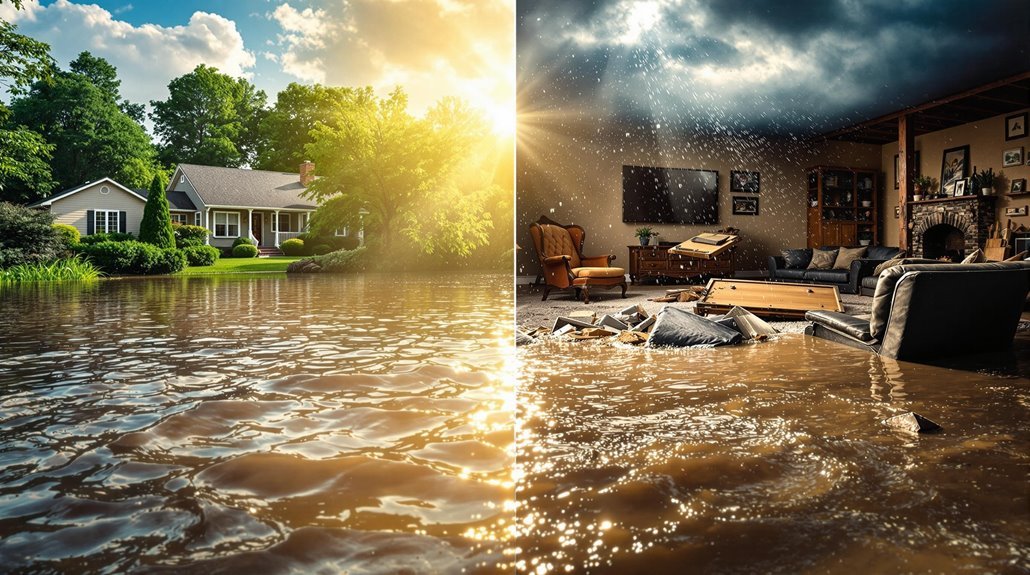
When heavy rainfall accumulates faster than the ground can absorb it, flooding often occurs, leading to considerable property damage and safety concerns. Several factors contribute to this phenomenon. Inadequate urban drainage systems can't handle excessive rain, causing water to overflow onto streets and properties. Furthermore, rapid snowmelt can worsen flooding, especially in areas with poor drainage. Urbanization greatly impacts flood risks; impervious surfaces like concrete prevent water absorption, increasing runoff. Implementing effective flood prevention strategies, such as enhancing drainage infrastructure and creating green spaces, can mitigate these issues. Understanding these common causes of flooding allows you to take proactive measures to protect your property and community from potential disasters.
Common Causes of Water Damage
Many homeowners underestimate the risk of water damage, which can stem from a variety of sources. One common cause is leaky pipes, often hidden behind walls or under floors, leading to slow but significant damage over time. These leaks can create mold growth and structural issues if not addressed promptly. Moreover, basement flooding can occur as a result of heavy rainfall, improper drainage, or sump pump failure. This can result in extensive damage to belongings and the foundation itself. Regular maintenance and inspections can help you identify these issues before they escalate. Understanding these common causes empowers you to take preventive measures, safeguarding your home from the potentially costly consequences of water damage.
Insurance Coverage Differences
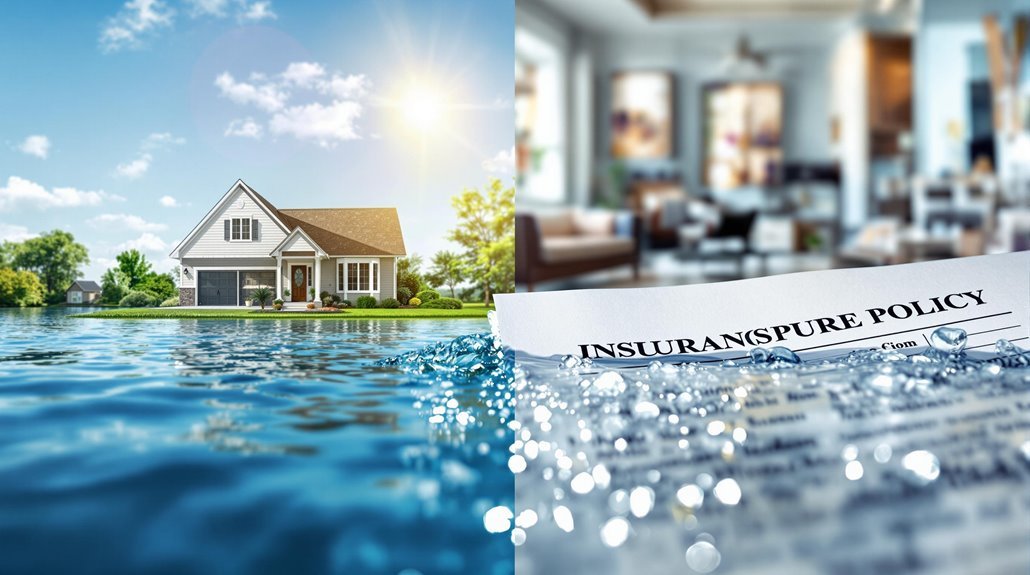
When it comes to insurance, understanding the differences in coverage for flood versus water damage is essential. Policies often have specific limitations, which can affect your financial protection in these situations. By examining the types of coverage available, you can better navigate the potential gaps in your insurance plan.
Coverage Types Explained
Understanding the differences in coverage types between flood and water damage insurance is crucial for homeowners. Flood insurance typically covers damage caused by rising water, while water damage insurance usually addresses issues like burst pipes or appliance leaks. Knowing these distinctions helps you choose the right policy options for your needs.
- Flood insurance requires a separate policy.
- Water damage may be included in standard homeowners' insurance.
- Coverage types vary greatly regarding what's protected.
- Deductibles and limits differ between policies.
- Understanding these nuances can save you from unexpected costs.
Policy Limitations Highlighted
While both flood and water damage insurance provide vital coverage, they come with specific limitations that can greatly impact your financial recovery. Understanding these policy exclusions is fundamental. For instance, standard homeowners' insurance typically excludes flood damage, necessitating separate flood insurance. Conversely, water damage from plumbing issues may not cover certain scenarios, leading to coverage gaps.
You must carefully review your policy to identify what's included and what's not. Often, deductibles and limits can vary markedly between policies, influencing your out-of-pocket expenses during a claim. By recognizing these distinctions, you can better prepare for potential losses and guarantee you have the appropriate coverage in place to safeguard your finances in the event of a disaster.
Financial Implications of Each Type
When evaluating the financial implications of flood versus water damage, it's essential to take into account differences in insurance coverage, as many policies treat these events distinctly. You'll furthermore need to compare repair costs, since flooding often leads to more extensive damage and higher expenses. Moreover, each type of damage can affect your property value differently, impacting long-term financial stability.
Insurance Coverage Differences
Although both flood and water damage can wreak havoc on your property, the insurance coverage for each type varies greatly, impacting your financial recovery. Flood damage typically requires a separate flood insurance policy, often backed by the National Flood Insurance Program (NFIP), which has specific coverage limits. Conversely, standard homeowners' insurance usually covers water damage resulting from internal issues like burst pipes, but it may exclude certain scenarios. Understanding these differences is vital when filing insurance claims.
- Flood insurance is federally mandated for high-risk areas.
- Water damage might be covered under homeowners' policies.
- Coverage limits differ markedly between the two.
- Flood insurance often has a waiting period.
- Know your policy to avoid unexpected costs.
Repair Costs Comparison
Repair costs for flood and water damage can differ markedly, affecting your overall financial recovery. Flood damage often incurs higher repair costs because of extensive structural issues and contamination. Water damage, mainly from plumbing issues, might require less intensive repairs, focusing on materials like drywall and flooring.
During a damage assessment, professionals typically evaluate the source and extent of the damage, which directly impacts repair costs. For flood damage, you may face additional expenses like mold remediation and potential replacement of large appliances. Conversely, water damage might require less thorough measures, resulting in lower repair costs. Understanding these distinctions helps you budget more effectively and prepares you for potential out-of-pocket expenses during your recovery process.
Property Value Impact
The impact of flood and water damage on property value can be significant, often leading to long-term financial implications for homeowners. Understanding these distinctions is vital for your property assessment and resale value.
- Flood damage typically results in a lower appraisal and decreased buyer interest.
- Water damage might be less visible but can still affect perceived value.
- Repairing flood damage often requires extensive renovations, impacting your budget.
- Homes in flood-prone areas may face higher insurance costs, affecting overall value.
- Maintaining documentation of repairs can help mitigate value loss during resale.
Being aware of these factors allows you to make knowledgeable choices about your property and helps you navigate the complexities of real estate value effectively.
Restoration Process for Flood Damage
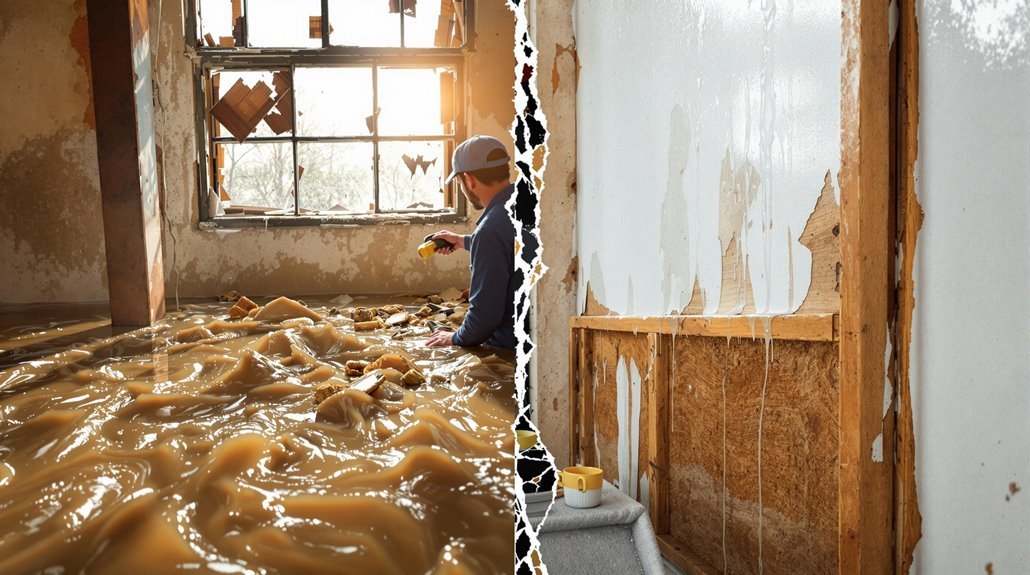
As water quickly infiltrates your property during a flood, initiating the restoration process becomes vital to mitigate long-term damage. First, conduct a thorough flood assessment to determine the extent of the damage and identify affected areas. This assessment guides your restoration techniques, ensuring you address significant issues promptly. Start by removing standing water using pumps and vacuums to prevent mold growth and structural instability. Next, dry out the affected materials, employing dehumidifiers and fans to reduce moisture levels. It's imperative to sanitize surfaces to eliminate contaminants introduced by floodwaters. Finally, inspect and repair any structural damage, replacing compromised materials. By following these steps, you can effectively restore your property and protect it from future flood-related issues.
Restoration Process for Water Damage
While water damage can occur from various sources, such as leaks, burst pipes, or appliance malfunctions, addressing it promptly is crucial to minimize further complications. The restoration process involves several critical steps:
- Assessment: Identify the source and extent of the damage.
- Water Extraction: Remove standing water using pumps and vacuums.
- Drying and Dehumidifying: Use fans and dehumidifiers to eliminate moisture.
- Mold Remediation: Inspect for mold growth and treat affected areas to prevent health hazards.
- Repairs and Restoration: Restore damaged structures and replace materials as needed.
Preventive Measures for Flooding
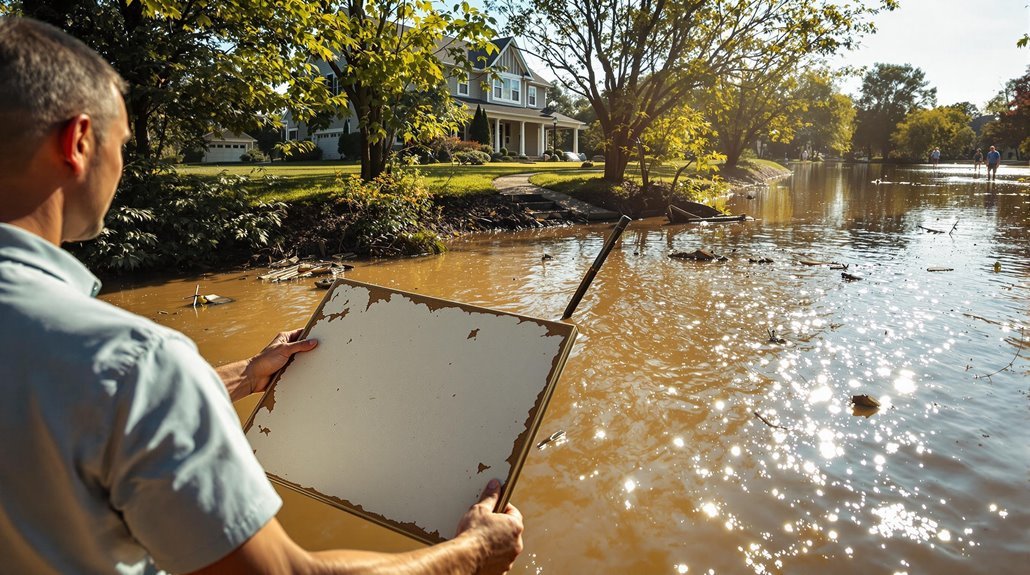
Water damage often prompts urgent restoration efforts, but preventing flooding in the first place can save you significant time, money, and stress. Implementing effective flood barriers and drainage systems is vital. Here's a quick overview of preventive measures:
| Measure | Description | Benefits |
|---|---|---|
| Flood Barriers | Structures that redirect water away | Protects property from floods |
| Drainage Systems | Systems designed to manage water flow | Reduces risk of standing water |
| Regular Maintenance | Routine checks and repairs | Guarantees peak functionality |
| Community Planning | Local policies for flood management | Improves overall safety |
Preventive Measures for Water Damage
Preventing water damage is vital for maintaining the integrity of your property and guaranteeing a safe living environment. Implementing effective preventive measures can greatly reduce risks. First, consider installing water detection systems that alert you to leaks early on. Regularly inspect your plumbing and appliances for wear and tear, as these are common sources of leaks. Furthermore, confirm your drainage systems are functioning properly to direct water away from your foundation.
- Clean gutters to prevent overflow.
- Seal windows and doors to minimize moisture entry.
- Use a sump pump in basements prone to flooding.
- Monitor humidity levels to prevent mold growth.
- Maintain landscaping to promote proper drainage.
Legal Considerations and Liabilities

When it comes to legal considerations and liabilities, understanding the differences in insurance coverage for floods versus water damage is essential. You'll need to clarify your responsibilities and potential liabilities, especially if damage occurs on your property. This knowledge can help you navigate claims and protect yourself from unexpected financial burdens.
Insurance Coverage Differences
Understanding the differences in insurance coverage for flood and water damage is crucial, especially since these terms often get used interchangeably in spite of their considerable legal distinctions. Flood damage typically falls under a separate insurance policy, often requiring a specific flood insurance plan with distinct coverage limits. On the other hand, water damage may be covered by standard homeowners' insurance, but only under certain circumstances.
- Flood insurance is mandatory in high-risk areas.
- Water damage coverage varies by policy.
- Coverage limits can greatly impact claims.
- Flood policies usually don't cover mold damage.
- Understanding your policy can prevent costly surprises.
Liability and Responsibility Issues
Insurance policies outline specific responsibilities and liabilities that can greatly impact how claims are handled in the event of flood or water damage. Understanding these liability concerns is vital for effective responsibility allocation.
| Scenario | Liability Type | Responsibility Allocation |
|---|---|---|
| Flood Damage | Federal vs. Local | Federal programs may cover |
| Water Damage | Homeowner's Insurance | Typically falls on homeowner |
| Mixed Events | Shared Liability | May require negotiation |
| Negligence Claims | Homeowner Liability | Homeowner responsible for upkeep |
Navigating these issues can prevent disputes and guarantee fair compensation. By being aware of your policy's nuances, you cultivate clarity in claims processing, ultimately safeguarding your financial interests.
Importance of Documentation and Claims
Documentation serves as a crucial tool in traversing the intricate terrain of flood and water damage claims. Understanding the documentation importance can greatly streamline the claims process and improve your chances of a favorable outcome. Accurate records provide clarity and evidence to support your case.
Consider the following key elements to document:
- Photos of damage before and after mitigation
- Written estimates from contractors
- Receipts for repairs or replacements
- Correspondence with your insurance company
- A detailed inventory of damaged items
Conclusion
Understanding the difference between flood and water damage isn't just important; it's absolutely essential. Ignoring this distinction could leave you drowning in confusion, financial woes, and potentially devastating legal troubles. Imagine your home being swallowed by a tidal wave of misinterpretation, leaving you stranded without coverage. By grasping these concepts, you arm yourself with the knowledge needed to protect your property and peace of mind. Don't let ignorance wash away your security—stay informed and prepared.
